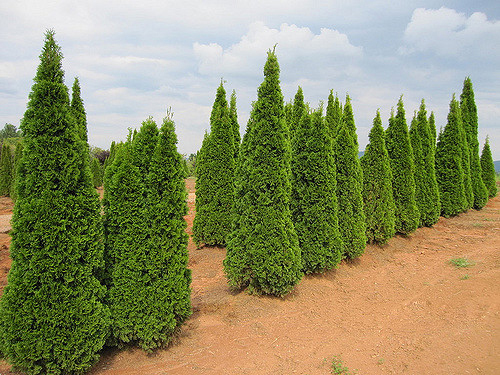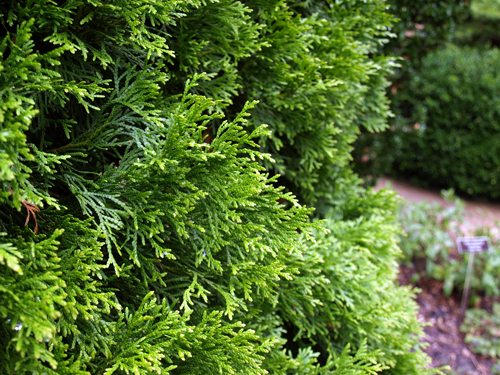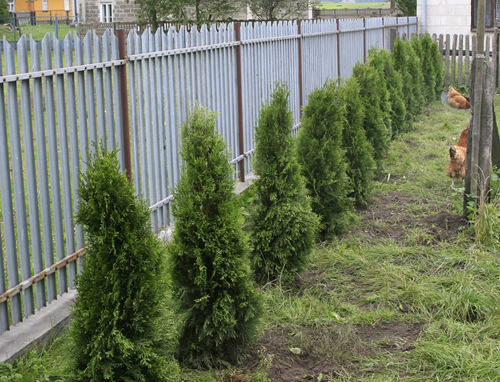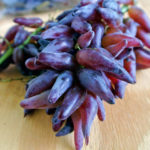Thuja western Smaragd
Tui has long and firmly held a reputation as one of the most popular evergreen trees used in landscape design. There are several species of these plants from the cypress family, one of which is Thuja western. In turn, a number of varieties and cultivars have been created within the species. About one of them - Thuja occidentalis Smaragd, we will now talk.

Features of appearance
So, the Smaragd variety originates from the western thuja, a primordially American species. And although all varieties of "American women" are in many ways similar, our heroine has her own distinctive abilities. In general, they boil down to the following characteristics.
- The crown shape is strictly pyramidal. The tree, even in the absence of pruning, retains its slenderness, does not "fall apart" to the sides.
- It grows slowly, usually no more than 20 cm per year. In exceptional cases, it grows up to 10 meters in height, but is mainly limited to 3-5 meters in size.
- The crown diameter rarely exceeds half a meter, sometimes it can grow up to one and a half meters.
- The color of the needles is extremely rich, does not fade even after severe frosts. It should be noted that among this variety there are cultivars with golden needles.
If we have already touched on Smaragd's options, we will consider them in a little more detail.

Varieties of the Smaragd variety
Janed Gold Smaragd
It is she who can boast of a golden-yellow crown that glows in the sun like dark amber! In addition, the tree retains this color both in warm seasons and in winter. Needless to say, such thujas are especially popular, especially since they are distinguished by the compactness of the crown, which rarely grows above 2 meters.
Janed Gold is unpretentious, like all of its brothers, but it is still more demanding on air pollution, and does not grow well in urban gas pollution. Prefers higher, in comparison with the standard, soil moisture.
White Smaragd
Slightly larger than the previous variety, but also with a compact, pyramidal crown. There is no golden color in her color, but there are blurry, white-cream blotches. The needles are soft, silky to the touch, the twigs are very dense. Differs in slow growth, no more than 10 cm per year. This allows you to prune and form a tree relatively rarely, without spending a lot of time. Besides "White" is unpretentious, can grow even in the city, adapts to dry or, on the contrary, excessively wet soil.

Smaragd Variegata
The name says a lot about the main feature of this variety. On its rich, green crown, creamy-whitish tips stand out clearly. They are much more noticeable than the specks of the White Smaragd thuja. Thanks to this combination of green and cream, the tree looks stunning!
The shape of the crown is narrow-conical, dense, elongated upward. It grows poorly in arid soil conditions, quite demanding on good lighting.
Smaragd Witbont
The main feature is extremely slow growth. It takes at least ten years for the bush to reach 2 meters. Due to this, it is especially often used to create hedges. Like "Variegat", the tips of its shoots initially have a distinct creamy shade, but over time they acquire a light green.
The variety is new, but it has already won the recognition of gardeners, especially since it perfectly tolerates the conditions of urban gas pollution.
Smaragd Spiral
Its crown has a natural tendency to curl into a spiral cone. This feature can be easily enhanced with timely and skillful pruning. The result is an expressive crown that resembles a wide corkscrew or screw. This allows the tree to be used as a single decorative element, but it is also great in a group or as a hedge.

General care instructions
Having considered, in this way, the main variations of the western thuja Smaragd, we can make generalizations and give a number of tips for caring for this ornamental plant.
All Smaragdas are generally unpretentious, although there are some options depending on the variety. They easily adapt to changing conditions, are flexible, and can grow both on dry and moist soils. They prefer bright places, but they also tolerate partial shade. The growth rate of these thuja is slow, the crown is compact, and forms a beautiful pyramidal shape. Even for decades, they rarely grow more than three meters. It should be said that these are long-lived plants for which a hundred years is not the limit.
Speaking of user benefits, it is necessary to emphasize the versatility of Smaragd. All of its varieties are excellent ornamental plants, capable of creating picturesque hedges, acting as a leader in a particular group of green spaces, or even showing themselves as a solitary plant. The most important quality of Smaragd is the ability to retain a juicy, saturated color of the crown throughout the year, including winter, when many conifers become dull and redden.
In short, in order for this variety of western thuja to develop well and please the owner, the following conditions are needed:
- the place is sunny, at least not a dense shade;
- lack of constant, strong winds;
- well-drained land, without stagnant water, preferably with an admixture of coarse sand or fine gravel;
- regular fertilizing with mineral fertilizers in the warm season;
- high-quality, professional pruning, even if rare, given the slow growth of shoots;
- additional covering of roots for the winter, especially in the first 2-3 years of life;
- make sure that the root collar is not buried in the soil.
Of course, these recommendations are generalized in nature, they should not be considered as a complete guide to caring for thuja. However, they give the correct idea of the plant that you plan to "settle" on your site.









Now I use it as a fence. At one time I could not learn to propagate it, all the time the cuttings were dying. But now experienced people have taught. In order to propagate the Smaragd Spiral, it is enough to cut off small branches from an adult plant and plant them in the holes, you can add a little Kornevin, moisten abundantly with water, preferably plant in the shade. Then the cuttings must be watered so that the earth is constantly wet. I usually plant in the spring, and by autumn 5-7 plants take root out of 10 cuttings. After rooting, they can be left in the same place or transplanted to another. For the winter, it is advisable to wrap them up with spunbond, otherwise they can freeze out.
Thuja Smaragd has been growing on my site for the second year. Planted in a sunny location protected from the wind. In the summer I watered and rained as recommended. The first season, from spring to autumn, everything was fine.
In early spring, the lower branches began to turn brown and dry. I decided that the reason was the neighbour's cats, which in a certain way spoil my tree. But dry twigs began to appear higher, which led to the idea of a fungal infection of the crown. The disease spread, some of the branches had to be cut out. An ugly bald patch has formed.
Tuyu urgently began to save her: she treated her with special antifungal and immunity-stimulating agents. To my great joy, new ones began to appear in place of the cut branches. In general, thuja has grown well over the summer, prettier.